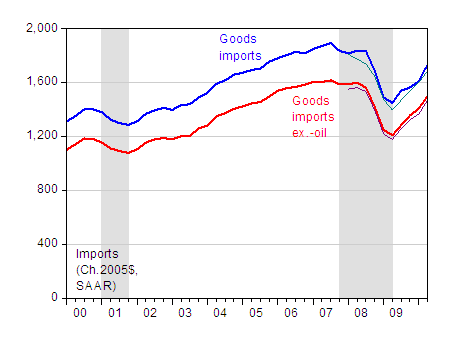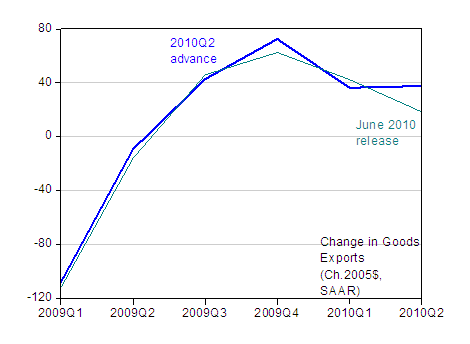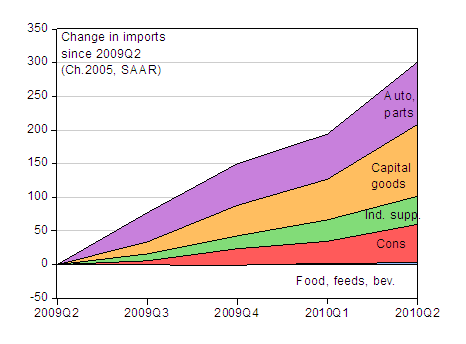The recent trade release for June sparked some consternation, as it indicated 2009Q2 growth, conditional on data already released, would be lower. But there was also some unhappiness as it was taken by some to mark the return of the spendthrift consumer.[0] Yet, everywhere I see discussion of how consumption is lackluster, because households are deleveraging and beset by uncertainty. [1] These two narratives clash. Which one is right?
As Figure 1 shows, the 2009Q2 advance release and the monthly trade figures match up pretty well for goods ex.-oil. The match for total goods imports doesn’t share the same contours, due in part coverage differences and perhaps due to seasonal adjustment issues. [2]

Figure 1: Real goods imports (bold blue), real goods imports ex.-oil (bold red), from NIPA, and real goods imports (teal), and real nonpetroleum goods imports (purple), from BEA/Census. All in Ch. 2005$, SAAR. NBER defined recessions shaded gray; assumes last recession ended 09Q2. Sources: BEA, 2010Q2 advance GDP release; and BEA/Census, June 2010 trade release, and NBER.
On the export side, the NIPA and trade data deviate a bit more (Figure 2), but what matters are the changes. And here the change in goods imports implicit in the 2010Q2 advance release differs from the change implied by the trade release, as shown in Figure 3. This is what is most troubling.

Figure 2: Real goods exports, from NIPA, and real goods exports (teal), from BEA/Census. All in Ch. 2005$, SAAR. NBER defined recessions shaded gray; assumes last recession ended 09Q2.Sources: BEA, 2010Q2 advance GDP release; and BEA/Census, June 2010 trade release, and NBER.

Figure 3: Change in real goods exports (bold blue), from NIPA, and change in real goods exports (teal), from BEA/Census. All in Ch. 2005$, SAAR. Sources: BEA, 2010Q2 advance GDP release; and BEA/Census, June 2010 trade release.
Now, let’s turn to the import side. Is it true that consumers are sucking in imports? Certainly, real goods imports jumped from May to June, by 155% on an annualized basis. But a single observation doesn’t make a trend, so I’ll rely on the NIPA data which seems to match pretty well the trade data. Figure 4 depicts the components of non-oil goods imports. What is clear is that consumer goods do not vary that much; now, part of auto and auto parts is going to satisfy consumer demand as well, and here we do have some evidence in support of the hypothesis of the consumer going back to his/her old ways of sucking in imports.

Figure 4: Real goods imports by category. All in Ch. 2005$, SAAR. Sources: BEA, 2010Q2 advance GDP release.
In order to identify clearly how much of the bounceback in non-oil goods imports are associated with each category, one can normalize on the trough, which I will place at 2009Q2. This yields the following picture.

Figure 5: Real goods imports by category, relative to level since 2009Q2. All in Ch. 2005$, SAAR. Sources: BEA, 2010Q2 advance GDP release.
To me, this indicates that the story is a bit more complicated than at first glance appears. Capital goods constitute a large chunk of the import story. Now, it might be the case that these capital imports are being driven by investment to satisfy anticipated consumer demand in the future. Alternatively, the capital goods could be being imported to satisfy anticipated foreign demand.
Just to recap, here are the latest readings on personal consumption, and retail sales (the latter annualized).

Figure 6: Nominal personal consumption expenditures, from NIPA (blue line, left axis), and retail sales and food services (red line, right axis), and retail sales and food services ex.-motor vehicles and parts. All in billions of dollars, SAAR. NBER defined recessions shaded gray; assumes last recession ended 09Q2.Sources: BEA, consumption and income release of August 3, 2010, and Census release of August 13, 2010, and NBER.
Consumption hardly seems resurgent, so attributing the increase in imports to consumers means that one is assuming a very high share of imports to incremental consumption — something I’m not sure makes sense. So, I think the book is still open on whether the consumer is going to drive the US back into a rapidly expanding trade deficit.
The June Trade Release: A Clash of Narratives
Disclaimer: This page contains affiliate links. If you choose to make a purchase after clicking a link, we may receive a commission at no additional cost to you. Thank you for your support!


Leave a Reply